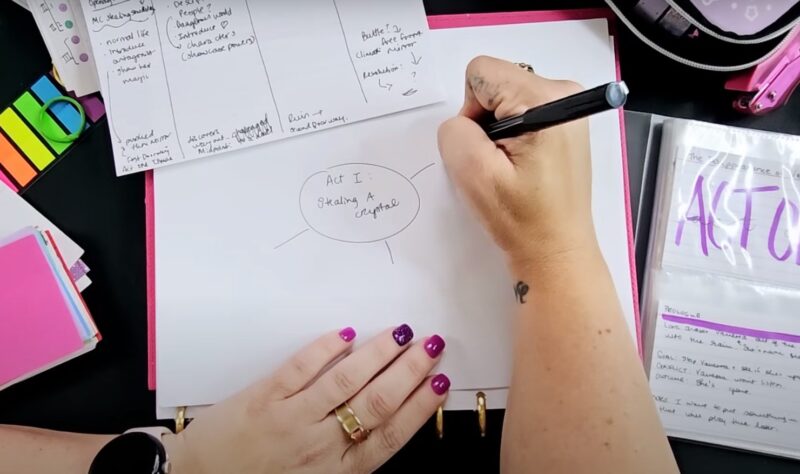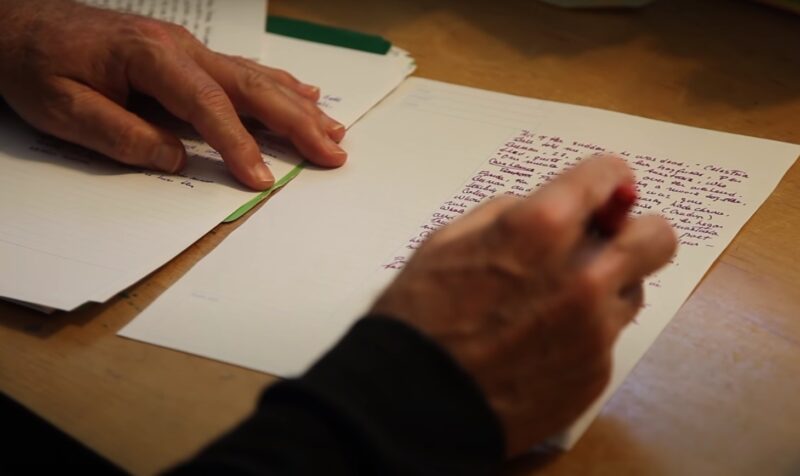In storytelling, the theme is way more than just a narrative. Its purpose is to be a heart and soul.
Unlike the plot, which tells you what happens, the theme reveals why things happen and what they mean on a deeper level.
Every character has its drivings and passions, and in many cases, they will not be named explicitly, the reader needs to recognize them.
Today, I want to share top tips on how to choose the perfect theme, which will carry the story until the end.
1. Contemplating Your Intentions

Before you start writing your story, you need to have a clear idea of why you are writing it and what you want to say.
It will help you narrow down your theme and make it more focused and relevant.
Clarify Your Storytelling Motivations
Ask yourself: What inspired you to write this story? What are you passionate about?
What are you hoping to achieve or communicate with your story?
Your answers to these questions will reveal your motivations and interests, which can guide you to your theme.
For example, if you are writing a story about a dystopian society, you might be motivated by your concern for the future, your curiosity about human nature, or your desire to challenge the status quo.
Pinpoint the Central Message to be Imparted
Once you have identified your motivations, you need to translate them into a central message or a thematic statement.
It is a concise and clear sentence that summarizes the main point or lesson of your story.
It should not be too vague or too specific but rather capture the essence.
- “Freedom is worth fighting for”
- “Power corrupts, but hope prevails”
2. Analyzing Your Genre
- Romance
- Fantasy
- Thriller
- Historical fiction
It can influence your theme, as different genres have different expectations, conventions, and common themes.
Identify With the Genre
Research and read other stories in your genre and take note of the themes that they explore.
Also, look for lists of common ones in your genre online or in books about writing.
This will help you get a sense of what is popular, relevant, and appropriate for your genre.
For example, some common themes in fantasy are: good vs. evil, heroism, destiny, magic, loyalty, and sacrifice.Match with Genre Conventions
Once you have a list of potential themes for your genre, you need to match it to the genre conventions.
These are the rules, expectations, and elements that define your genre and make it recognizable to your readers.
You need to make sure that it fits well with your genre and does not contradict or clash with it.
For example, if you are writing a fantasy story, your theme should not be too realistic or mundane but rather reflect the fantastical and imaginative nature of your genre.
Avoid themes that are too clichéd or overused in your genre unless you can put a fresh or original spin on them.
3. Structuring Your Outline

The outline acts as your story’s map or blueprint, guiding you through its main events, scenes, and plot points. It serves as a tool to structure your narrative while also reinforcing and strengthening its underlying theme.
Arrange the Plot to Accentuate the Topic
Plot is the sequence of events that make up your story, from the beginning to the end. It should not only be interesting and logical but also serve your theme.
Arranging your plot in a way that showcases, develops, and reinforces your theme throughout your story is essential for a cohesive and impactful narrative.
Structuring Your Plot
Once you have a clear setting, structure your plot to highlight and emphasize it.
Here’s how to do it:
- Introduction:
- Begin your story by setting up the world and the main conflict that relates to your theme.
- If your theme is “freedom is worth fighting for,” introduce your protagonist in a setting where freedom is restricted. Show their dissatisfaction and yearning for freedom.
- Rising Action:
- As the plot progresses, place your protagonist in situations that challenge their beliefs and reinforce the theme.
- In a story about fighting for freedom, this could involve showing the increasing oppression of the dystopian regime and the protagonist’s initial acts of defiance.
- Climax:
- The climax should be a pivotal moment that directly ties to the setting. This is where the protagonist makes a crucial decision or takes a significant action that embodies his story.
- For instance, a major rebellion or a crucial battle against the oppressive forces could serve as the climax in a story about freedom.
- Falling Action:
- After the climax, depict the immediate fallout of the protagonist’s actions. These events should further underscore the theme.
- If the theme is “freedom is worth fighting for,” show both the sacrifices made and the gains achieved as a result of the rebellion.
- Resolution:
- Conclude your story in a way that leaves a lasting impression on the readers.
- Their experience
- Changes in society
- Personal growth they’ve experienced
Ensure that the resolution ties back to the initial conflicts and questions raised by the theme.
4. Adding Motifs
A motif is a recurring element, symbol, image, or idea that relates to your theme and emphasizes its significance.
Motifs can help you create connections, contrasts, and patterns in your story that highlight your theme.
Employ Consistent Symbols
A symbol is something that represents or stands for something else, usually an abstract concept or idea.
Symbols can be objects, characters, settings, colors, sounds, or anything else that has a deeper meaning or significance.
When used effectively, symbols can deepen the thematic resonance of your story, making it more impactful and memorable.
Powerful Symbols
Here’s how to use symbols to reinforce your theme:
- Identify Key Symbols Related
- Start by brainstorming objects, characters, settings, or other elements that naturally connect to your theme.
- Crown (power)
- Sword (corruption)
- Bird (hope)
- Flower (resilience)
- Introduce Symbols Early
- Introduce your key symbols early in the story to establish their significance. For instance, you might describe a grand crown worn by the corrupt ruler in the opening scene, setting the stage for power and corruption.
- Use Symbols Consistently
- Ensure that your symbols appear consistently throughout the story. Repetition helps to reinforce their significance and keeps it in the reader’s mind. If a bird symbolizes hope, you might include scenes where the protagonist notices birds during moments of despair, symbolizing that hope is still present.
- Develop Symbolic Layers
- Allow your symbols to evolve and gain deeper meaning as the story progresses. A flower that starts as a simple sign of resilience might, by the end of the story, become a powerful emblem of the protagonist’s growth and the collective strength of the people.
- Contrast Symbols for Emphasis
- Use contrasting symbols to highlight conflicts and contrasts within your theme. For example, juxtapose the dark, imposing imagery of a sword with the delicate, vibrant imagery of a flower to underscore the battle between corruption and hope.
- Include Symbols into Key Moments
- Weave your symbols into crucial plot points and character arcs. In a climactic scene, the destruction of the corrupt ruler’s crown could symbolize the fall of corrupt power, while a bird soaring overhead might symbolize the triumph of hope.
5. Diversifying Themes
A subject is not a fixed or rigid concept, but rather a flexible and dynamic one. Diversify your theme by exploring different aspects, perspectives, and implications of it in your story.
Integrating Primary and Subordinate Themes
Here’s how to effectively integrate a primary theme with subordinate ones:
Interconnected Storylines
Develop interconnected storylines that revolve around the primary subject but explore subordinate ones.
- Identify the Primary Theme
- Clearly define the central theme of your story. This will be the core around which all other storylines revolve. For example, if the primary theme is “freedom is worth fighting for,” this central idea will guide the development of all plotlines.
- Create Subordinate Themes
- Identify secondary themes that can support or contrast with the primary theme. These could include themes like love, betrayal, courage, sacrifice, and identity. Each subordinate theme should have its own storyline.
- Develop Main Plotline
- Outline the main plotline that directly addresses the primary setting. This plotline will follow the protagonist’s primary struggle and journey.
- Outline Subplots:
- Develop subplots that explore the subordinate subjects. Each subplot should have its own protagonist or set of characters, events, and conflicts that relate to the main plotline.
- Interweave Storylines
- Interconnect the subplots with the main plotline. Characters from different storylines should interact and influence each other’s journeys. Events in one subplot can have repercussions in another, creating a cohesive and interlinked narrative.
- Balance and Pacing
- Ensure that each storyline gets adequate attention and development. Balance the pacing by alternating between different storylines, keeping the narrative dynamic and engaging.
Character Arcs
Use character arcs to explore subordinate themes. A protagonist’s journey might primarily focus on fighting for freedom, but their relationships and personal growth can touch on love, betrayal, and courage.
Supporting characters can embody different subordinate themes, adding complexity and depth.
Symbolic Elements
Employ symbols that represent both primary and subordinate themes.
A flag might symbolize freedom, while a locket could represent love and betrayal, and a broken sword might signify sacrifice. These symbols can appear throughout the story to reinforce thematic connections.
6. Characterization

The characters are the people who populate your story and drive the action. They can also help you convey your theme, as they embody, express, or challenge it through their personalities, actions, and interactions.
Manifest the Subject Through Narratives
A character narrative is the story arc or development of a character, from their introduction to their resolution.
A character narrative can manifest your theme by showing how a character relates to, learns from, or changes because of the theme.
7. Gaining Perspective

Writing a theme is not a one-time or linear process, but rather a cyclical and iterative one.
Gain perspective by revisiting, revising, and refining it throughout your writing process.
This will help you make your theme more clear, consistent, and compelling.
Step Back to Better Perceive the Thematic Elements
Sometimes, you might be too close or too attached to your subject, which can make you lose sight of the bigger picture or the finer details.
Step back and distance yourself from the main story so that you can better perceive the thematic elements in your story and how they work together.
You can do this by taking a break from writing, getting feedback from others, reading your story aloud, or using tools such as mind maps, charts, or diagrams to visualize your story and its components.
8. The Art of Subtlety

One of the key skills of writing a theme is to be subtle and not forceful. You don’t want to hit your readers over the head with your theme or make it too obvious or preachy.
Instead, you want to enable the audience to deduce the theme from the story and appreciate its nuances and implications.
Enable the Audience to Deduce the Theme
To do this, you need to show, not tell, your theme. This means using the elements of storytelling, such as plot, character, setting, dialogue, and action, to illustrate your theme, rather than stating it explicitly.
Weave in Motifs Progressively
Another way to be subtle is to weave in motifs progressively throughout your story. Motifs are recurring elements, symbols, images, or ideas that relate to your theme and emphasize its significance.
They can help you create connections, contrasts, and patterns in your story that highlight your theme.
9. Infusing Your Voice

Another aspect of refining your theme is to infuse your voice into it. Your voice is your unique style and personality as a writer, and it reflects your perspective and attitude towards your theme.
By infusing your voice, you can make your theme more original, authentic, and engaging.
Imbue the Theme with Your Insights
To infuse your voice, you need to imbue the theme with your insights. This means drawing from your own experiences, opinions, values, and emotions, and expressing them through your theme.
Use your voice to challenge, question, or explore different aspects, and to invite your readers to do the same.
10. Avoiding Common Pitfalls
Refine your theme carefully to sidestep pitfalls such as being too vague, too specific, too moralistic, or too clichéd.
- Avoid Vagueness: A vague theme, broad or abstract, can blur your story’s focus and confuse readers.
- Sharpen your theme by brainstorming, outlining, and crafting a precise thesis statement.
- Avoid Over-Specificity: A narrowly defined theme can strip your story of depth and alienate readers.
- Broaden your theme to encompass universal relevance through analysis, synthesis, and generalization.
- Avoid Moralism: A preachy theme can reduce your story’s nuance and alienate readers.
- Strive for balance by showcasing different perspectives and employing motifs and a nuanced narrative voice.
- Avoid Clichés: A clichéd theme, overly familiar and uninspired, dulls your story’s impact.
- Revitalize your theme by questioning and exploring new angles, and infusing it with a unique voice.
Final Reflections
In storytelling, the theme is the core that elevates a narrative beyond mere events to impart deep insights and universal truths, reflecting on the human experience. It goes beyond the plot to add depth and resonance, transforming stories into unforgettable journeys.
A clear intention and genre analysis shape the theme, ensuring it aligns with narrative elements and genre norms for coherence and relevance. Employing motifs, diverse thematic aspects, and character development enriches the narrative, while subtlety in theme presentation and the author’s unique voice add nuance.
Related Posts:
- Story Structure 101 - Build the Perfect Plot for Your Film
- How To Turn Your Ideas into Scripts - From Concept…
- 80 Cliched Dialogues NOT to Include in Your Script
- Light Your Scenes Without Breaking the Bank: DIY…
- How to Network with Other Filmmakers in Your Region
- Get Your Film Seen - Why Distribution Matters








